Alpine plants are small, compact, hardy plants that thrive in colder climates with rocky soil. They don’t usually require much maintenance and look stunning when planted together in a rugged, natural space. So, exactly what is an alpine garden? In this post, we look at what makes a great alpine garden, including a selection of alpine garden plants for you to try.
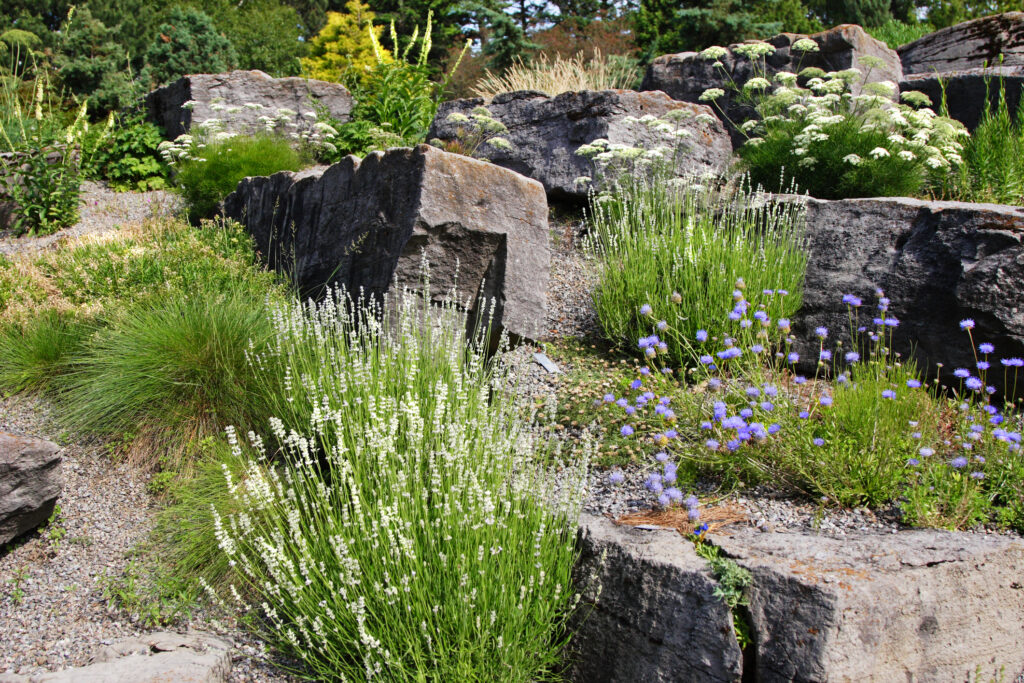
What is an Alpine Garden?
An alpine garden recreates the natural habitat of mountains, usually found in higher elevations. These gardens use low-growing plants to create a miniature landscape of rocky terrain, succulents, perennials and colourful flowers. Alpine gardens thrive in conditions that many larger plants cannot survive in, including extremely cold temperatures, barren rocky soil, and intense sunlight.
Why Make an Alpine Garden?
Alpine gardens are great for those who enjoy outdoor activities and exploring the beauty of nature. By utilizing imaginative design techniques and hardy plants, an alpine garden can be both stunningly beautiful and surprisingly resilient.
They often feature a mix of grasses, perennials, and flowering bulbs, often providing a good habitat for wildlife. They can help to attract birds, butterflies, bees, and other creatures to your garden.
Wherever you live, an alpine garden can recreate the unique beauty of mountainous areas and act as a welcome retreat from the hustle and bustle of everyday life.
Alpine Garden Design
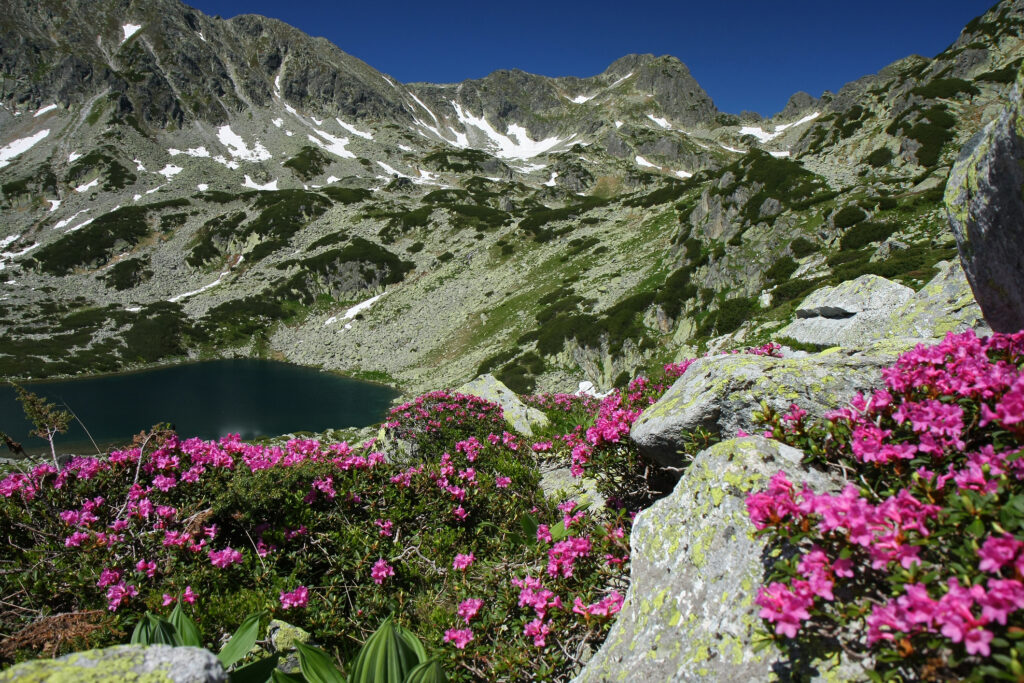
An alpine garden is most successful when designed with the local climate in mind. As these gardens thrive in cold temperatures and rocky soil, a good starting point for design is to use plants that are native to colder climates. This will ensure the success of your alpine garden and make it easier to maintain over time.
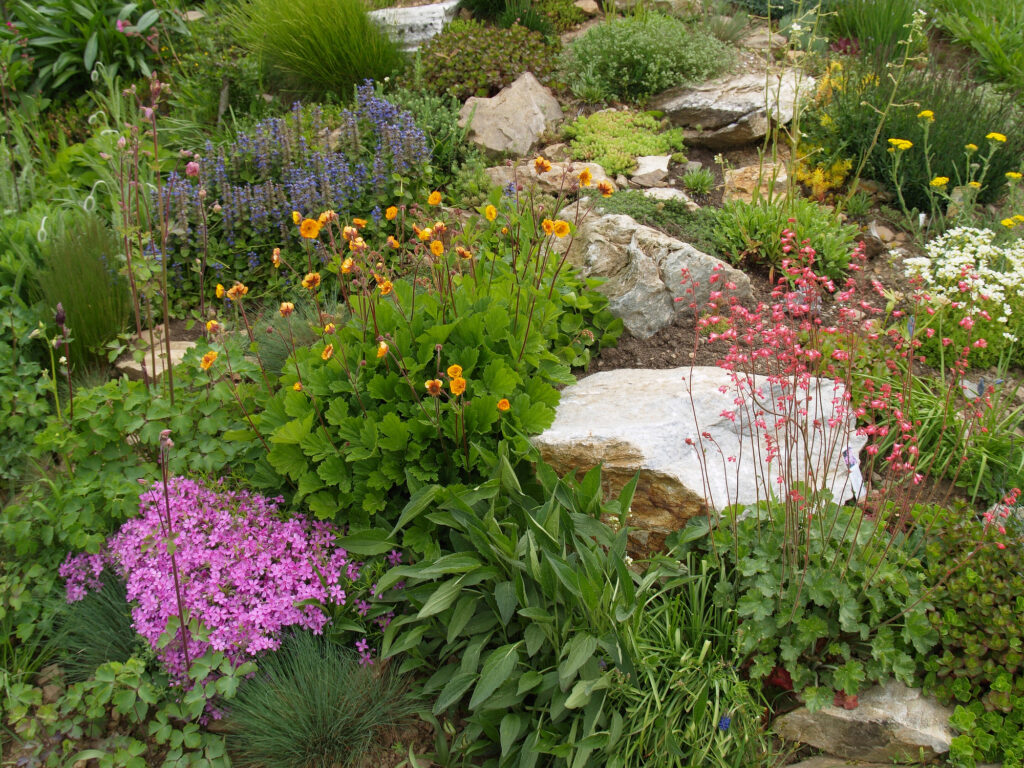
When designing an alpine garden, it’s important to think about the topography and rock formations of the space. Create a rock garden landscape that looks natural by using small boulders and rocks in different shapes and sizes. This will give your garden texture and provide extra protection for plants from extreme temperatures or wind.
Alpine Garden Plants for You to Try
When choosing plants for your alpine garden, look for ones that are hardy and low-growing. Here is a selection of some popular plants for an alpine garden:
Alpine Bulbs
Plant once and then enjoy them every year. Anemones, Crocus, Dwarf Daffodils and Snowdrops are all great for adding a splash of colour to your alpine garden. Also try Dwarf Iris for its stunning blue flowers in spring.
Besides being very easy to grow, some of these bulb varieties can also handle a little shade or partial sun.
Alpine Aster
Aster alpinus is a small perennial flower commonly known as the Alpine aster. Typically growing 6-12 inches in height, it flowers in mid-spring through to early summer with bright violet and sometimes white petals, making for a beautiful view among more rugged terrain. Its simple but bold shape adds to its beauty, and its delicate size ensures it fits perfectly into rock gardens and other barren landscapes.
Alpine Pasque Flower
Alpine Pasque Flower plants thrive in cold climates and are characterized by their showy, purplish-blue flowers and furry, silvery leaves. This low-growing perennial is known for being one of the earliest blooms of spring, often emerging even before the snow has melted. Reaching an average height of 4-8 inches, Alpine Pasqiue Flowers boast a vibrant cup-shaped flower – typically having five petals. A symbol of strength and hope, these short-lived but beautiful plants bloom from April to June in mountainous regions across Europe and Asia.
Alpine Poppy
Alpine Poppies are fascinating flowers, boasting a soft yellow colour, delicate petals that can be as small as one centimetre, and tiny centres of black stamens. This hardy plant is found in the small pockets of mountainous regions; they thrive on steep and rocky slopes that may otherwise seem unsuitable for planting. Clusters of Alpine Poppies in bloom transform even the most barren landscape into something marvellous.
Armeria
Armeria, commonly referred to as thrift or sea pinks, are a type of flowering plant with dense tufts of grass-like foliage from which small circular blooms emerge. Mostly grown in rock gardens and the edges of paths, their bright colours make them a welcome addition for displays in cooler climates. Blooms generally range from white to deep rose and appear from late spring into early summer and can even be cut to enjoy indoors. Easy to grow in well-drained soils and full sun, Armeria plants look best planted in large clumps and can live up to 10 years with proper care.
Creeping Thyme
Creeping Thyme is a popular choice in landscapes due to its enchanting purple and white flowers, hardy nature, and lovely aroma. Despite preferring dry, rocky soil and little water, it is easy to manage, forgiving of neglect and makes an excellent ground cover. Plus, it won’t suffocate other plants as taller ground covers can. It blooms in late Spring and Early Summer, making it a much-beloved addition to any alpine garden. Look out for Thymus ‘Silver Posie’, with its dark green, lemon-scented leaves and pale lilac flowers.
Dianthus
Dianthus plants are beautiful flowers with a distinctive fringed petal look. They come in a variety of colours and many have scents that range from sweet to spicy. These hardy perennials make for a great low-maintenance addition to any garden. Most dianthus blooms in spring, but some varieties can bloom year-round with enough sun and water. If you’re looking for something durable and eye-catching, dianthus is a perfect choice. Try Dianthus ‘Popstar’ with its bright pink flowers in spring.
Lithodora Diffusa
Lithodora diffusa is a small flowering evergreen perennial. This compact plant has dark green needle-like leaves and is native to rocky areas along the Mediterranean coast. Its beautiful star-shaped flowers in blue or white appear throughout warmer seasons attracting butterflies and creating a stunning sight among rock walls or sunny borders. Notable varieties t look for are ‘Heavenly Blue’ and ‘Grace Ward’.
Saxifrages
Saxifrages can grow in different climates, from forests to mountains. Depending on the species, they might have pretty flowers that are often pink or white. Saxifrages need soil that drains well and full sunlight to grow, so they are often planted in flowerbeds. They also do well in cool weather and can survive frost. They’re easy to take care of, which makes them a good choice for anyone looking for a reliable plant that will last a long time. Try Saxifraga ‘Tumbling Waters’, as this spreading evergreen produces white flowers and is perfect for adding texture to an alpine garden. Otherwise, Saxifraga ‘Winifred Bevington’, is also evergreen and produces pink flowers in spring.
Phlox Subulata
Phlox ubulata, commonly known as moss phlox or creeping phlox, is an evergreen perennial with needle-like foliage and beautiful clusters of five-petaled flowers. The flowers come in shades of pink, lilac, lavender and white, making them essential for spring pollinator gardens. The plants like full sun and well-drained soil, forming a dense carpet up to 1 foot tall and spreading out 2 feet wide or more. Easy to grow and trouble-free, the low-growing variety adds interest to walls and pathways with its abundance of blooms. Try ‘McDaniel’s Cushion’ for its bright blue flowers in summer, creating a carpet of colour!
Sedums
Sedum plants are incredibly low maintenance and drought tolerant; they require little water and grow even in rocky soils or shallow soils on top of paving stones.
Sedums are perfect for filling out your alpine garden as they come in a variety of heights, colours and shapes. While some species are short enough to act as groundcover between walkways, others can climb walls, making them a lovely addition to almost any landscape. Try Sedum ‘Angelina’, which has golden-yellow foliage and pink flowers in summer. Also, look for Sedum Spathulifolium ‘Purpureum’; an evergreen with purple-pink flowers in summer and prefers sunny spots.
Sempervivum
A Sempervivum plant, also known as a “Hens and Chicks plant” is a type of succulent that has gained popularity due to its low-maintenance nature. sempervivums are perfect for gardeners of all levels – they prefer well-drained soil in bright, indirect light and may even thrive if slightly neglected! In the right environment, these plants can grow up to six inches tall with rosettes of colourful foliage in shades of jade green, almond yellow, and deep purple. They also produce beautiful flower spikes during their blooming season with varieties ranging from white to vibrant pink hues. Overall, Sempervivum plants make a unique addition to any garden or home and are sure to bring hours of joy!
Campanula
Campanula plants are perennials beloved for their star-shaped or bell-shaped flowers in shades of white, blue, and purple. They spawn a large range of varieties growing in many climates, from the low-growing creeping varieties to tall upright forms with clusters of dainty blossoms ideal for cottage gardens. Campanulas thrive in full sun to partial shade and need moist, yet well-drained soil. These easy-care plants boast long bloom times during the summer months making them an enjoyable addition to home gardens.
Primulas
Primula plants, also sometimes referred to as Primroses, are flowering perennials that grow wild in alpine regions of Europe. With colourful and attractive flowers in shades ranging from soft yellow to bright pink, they make ideal additions to any alpine garden. The low-growing habit that Primula exhibits make them perfect for growing near the front edge of a flower bed or for mass planting beneath deciduous trees. They thrive in cool climates with moist soil and should be sheltered from full sun exposure. Primula is the perfect choice for any gardener looking to add splashes of colour and vibrancy to their alpine retreat!
Veronica Prostrata
Veronica Prostrata is a flower species native to Europe and temperate regions of Asia. This plant typically grows low to the ground, forming mounds with small but abundant bright blue flowers. An easy-care option for gardeners, it can tolerate periods of drought and only requires occasional pruning to keep its appearance tidy. Popular as an edging plant or as part of rock gardens and other low-maintenance displays, Veronica prostrata is known for its long season of blooms lasting several weeks in midsummer.
Storkbill
Storkbill plants are known by their unofficial name “purple showers” due to the clusters of small, deep purple-coloured flowers that prolifically bloom from midsummer onwards. This hardy plant is a member of the annual geranium family and has a rather elegant look with white-veined leaves and attractive, star-shaped petals. Storkbill plants don’t require green fingers as they are fairly low maintenance, thriving in sunny areas with poor soils and typically reaching up to 40cm in height.
How to Build an Alpine Garden
An alpine garden is a perfect way to showcase all of these beautiful, low-maintenance plants. Here are some tips on how to create a stunning alpine retreat in your own outdoor space:
• Start by selecting a sunny spot with well-draining soil and plenty of air circulation.
• Use rocks, mulch, and other organic materials to create a miniature landscape within your garden.
• Add plants that can tolerate harsh conditions such as a lack of water and strong winds.
• Group plants together that require similar levels of care and maintenance.
• Incorporate pathways into the landscape design for easy access and movement among plants.
• Water regularly but lightly by hand, as alpine plants can be prone to rot.
• Prune and deadhead regularly to keep your garden tidy and encourage new growth.
• Enjoy the changing seasons with a diverse selection of colourful plants!
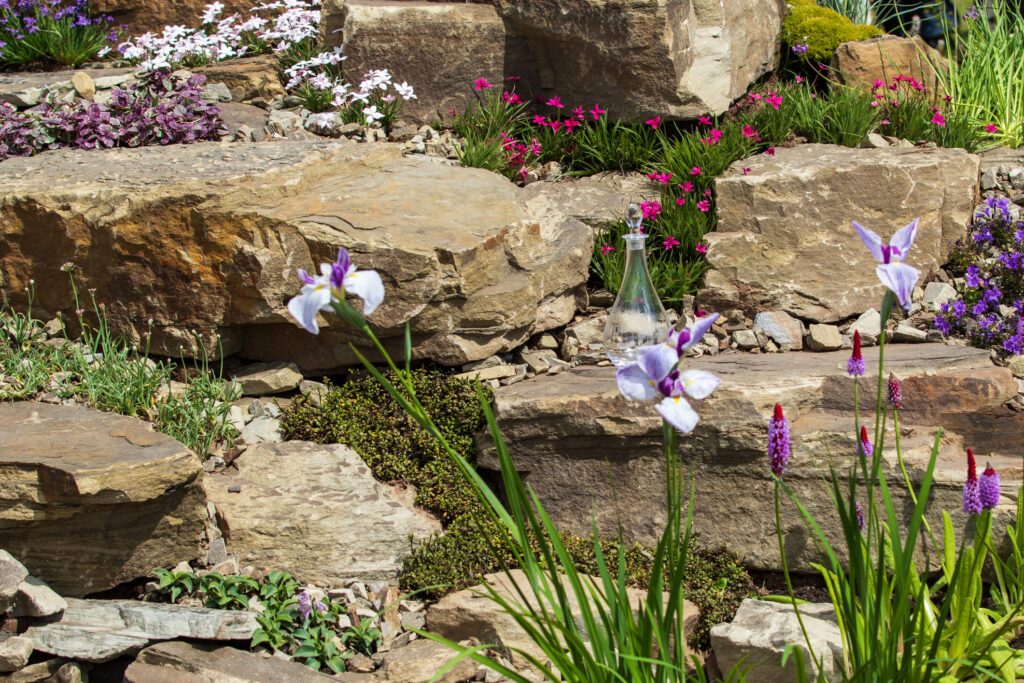
What Time of Year Can You Plant Alpines?
.Alpine plants can be planted at any time of year, although the best time to plant is usually in late spring or early summer. This allows the plants to become established before winter and benefit from the warmer weather. If planting in autumn, try to give them plenty of protection against colder temperatures and strong winds.
Do Alpines Come Back Every Year?
Most alpine plants are hardy and can survive cold winters, although some varieties may require extra protection by mulching or moving to a sheltered spot. In general, if the roots have been able to remain undisturbed over winter then most alpines will return the following spring. However, it is always advisable to check your particular species for more specific care instructions.
Where Can I Make My Alpine Garden?
There’s really no limit to where an alpine garden might work, provided you can provide the right soil and conditions for alpine plants to thrive. Alpine gardens can be as big or small as you have the space for. You could style your whole garden into a rocky alpine meadow or just choose a sunny corner somewhere to create a miniature mountain landscape.
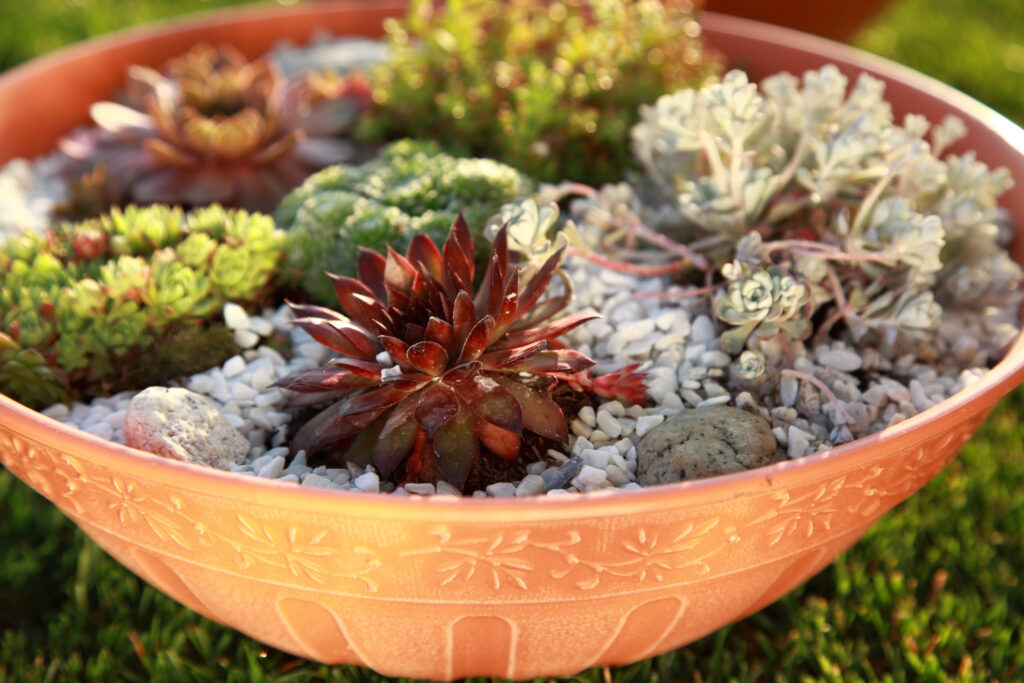
And if you want to enjoy some alpine planting ideas on a balcony garden or patio area, you could even create a container alpine garden.
Adding Water: Alpine Water Feature Ideas
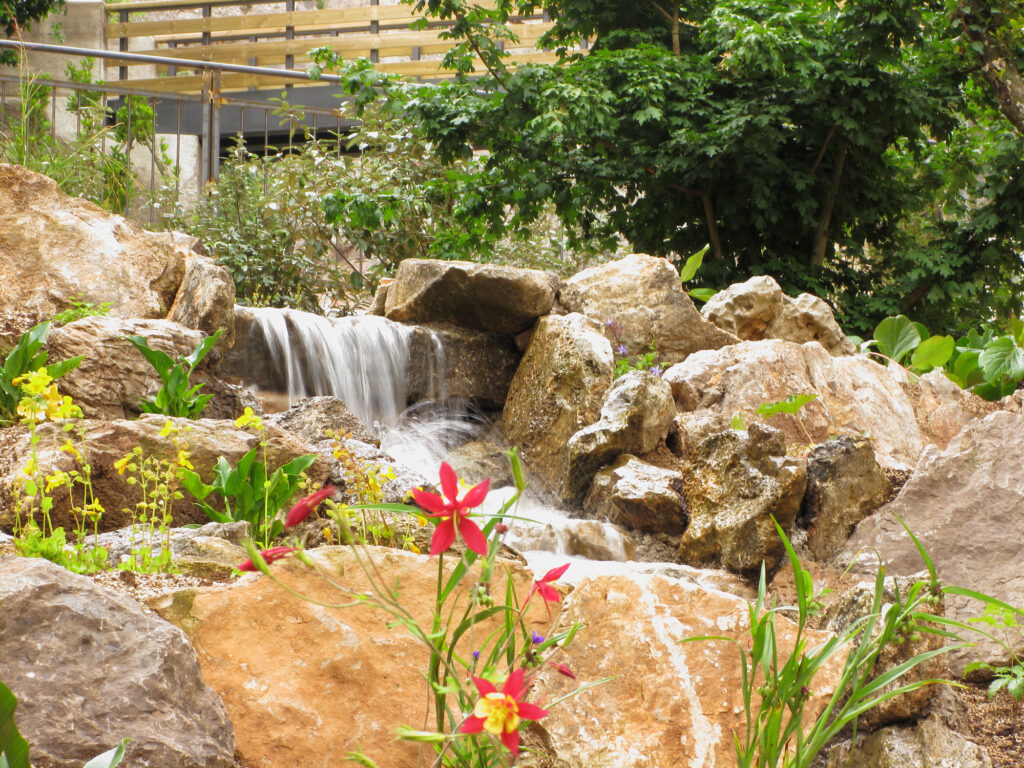
One of the best ways to add interest and beauty to your alpine garden is by incorporating a water feature. Whether you choose a cascading waterfall or a tranquil pond, adding water to your landscape can create a natural atmosphere of peacefulness and serenity. Here are some ideas for incorporating water features into your alpine landscape:
• Install a man-made waterfall or stream that cascades over rocks and gravel.
• Construct a small pond with decorative stones, aquatic plants, and fish.
• Set up a bubbling fountain among your plants for soothing background noise.
• Add an elegant birdbath surrounded by colourful flowers to attract feathered friends.
• Include a bubbling rock for an easy and low-maintenance water feature.
• Install a rustic barrel water fountain surrounded by native plants.
• Design a unique babbling brook that winds through your alpine garden.
These are just some of the ways you can add water to your alpine landscape for a truly unique and beautiful garden. With some creativity, you can create a tranquil oasis for yourself to enjoy all year round!
Final Thoughts
Alpine gardens have a unique charm that is incredibly rewarding for gardeners of all levels. Whether you’re looking to create a tranquil retreat or a dramatic paradise, you can use these tips and ideas to design your very own low-maintenance alpine garden. So get out there and start experiencing the beauty of alpine plants!
What’s growing in your alpine garden? Any tips or ideas to share? Let us know in the comments!
